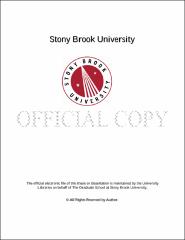| dc.identifier.uri | http://hdl.handle.net/11401/77573 | |
| dc.description.sponsorship | This work is sponsored by the Stony Brook University Graduate School in compliance with the requirements for completion of degree. | en_US |
| dc.format | Monograph | |
| dc.format.medium | Electronic Resource | en_US |
| dc.language.iso | en_US | |
| dc.publisher | The Graduate School, Stony Brook University: Stony Brook, NY. | |
| dc.type | Dissertation | |
| dcterms.abstract | The dissertation follows the survival of letters in literature in the early nineteenth century, after the popularity of overtly epistolary genres dramatically declined. It posits an " epistolary condition," referring to the combination of tradition (rhetorical, literary) and practice (material, structural) that shapes the Romantic text and the author's emergence in print. A historically specific tension between the letter, a genre defined by formal characteristics, and letters, a proto-medium of communication, the epistolary condition points to an underdeveloped counternarrative to that of Romantic genius and authorship. Each of three chapters analyzes a genre-defining work of Romanticism for the varied presentation of the self as the text serializes over time. Coleridge's conversation lyrics, Byron's first verse romance, and Poe's ratiocinative tales about C. Auguste Dupin each advance the epistolary tradition in the interplay of print and manuscript, while the writer's correspondence mediates the production of each text and its author. The " apostrophic relay" of address in Coleridge's series of poems introduces the idiom of the epistolary condition in the context of a historically shifting sense of communication. The chapter on Childe Harold's Pilgrimage reframes Byron's notorious " egotism" as a heroic relay of intersubjective encounters. Poe's Dupin tales are shown to play out a discursive relay of authorial and editorial modes under the constraints of American reprint culture. In addition to developing original interpretations of high canonical works, the dissertation advances a number of active conversations in the discipline. It shifts the ground of scholarly engagement with the epistolary from the discourses of genre and the archive to that of media and mediation. In so doing, it joins other attempts to nuance the prevailing treatment of print culture as the determining medium of the early nineteenth century. Finally, it models a practice of " surface reading," one recent answer to symptomatic reading, and prioritizes the significance of the epistolary condition to the groundbreaking theory of " lyric reading." | |
| dcterms.available | 2017-09-20T16:52:55Z | |
| dcterms.contributor | Haralson, Eric | en_US |
| dcterms.contributor | Manning, Peter J. | en_US |
| dcterms.contributor | Goodman, Kevis | en_US |
| dcterms.contributor | Scheckel, Susan | en_US |
| dcterms.contributor | McGill, Meredith. | en_US |
| dcterms.creator | Neefe, Lauren | |
| dcterms.dateAccepted | 2017-09-20T16:52:55Z | |
| dcterms.dateSubmitted | 2017-09-20T16:52:55Z | |
| dcterms.description | Department of English. | en_US |
| dcterms.extent | 146 pg. | en_US |
| dcterms.format | Application/PDF | en_US |
| dcterms.format | Monograph | |
| dcterms.identifier | http://hdl.handle.net/11401/77573 | |
| dcterms.issued | 2015-08-01 | |
| dcterms.language | en_US | |
| dcterms.provenance | Made available in DSpace on 2017-09-20T16:52:55Z (GMT). No. of bitstreams: 1
Neefe_grad.sunysb_0771E_11688.pdf: 791131 bytes, checksum: 3d40c19011fce0fdbd5e329b0a11a6b3 (MD5)
Previous issue date: 2013 | en |
| dcterms.publisher | The Graduate School, Stony Brook University: Stony Brook, NY. | |
| dcterms.subject | Literature | |
| dcterms.subject | Byron, Coleridge, Letters, Poe, Poetry, Romanticism | |
| dcterms.title | Romantic Relays: The Epistolary Condition of Imagination in Coleridge, Byron, and Poe | |
| dcterms.type | Dissertation | |

